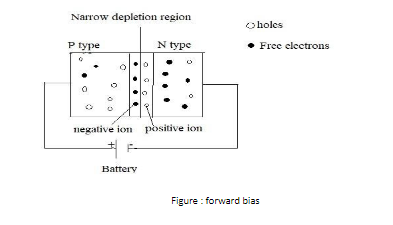
When p-n junction diode is forward biased, potential barrier
A. Remains same
B. increase
C. decrease
D. may increase or decrease
Answer
582.6k+ views
Hint: A p-n junction diode is formed when a p-type semiconductor is fused to an n-type semiconductor creating a potential barrier voltage across the diode junction. It is basically a semiconductor device that controls the flow of current in a circuit. In the forward bias condition, a negative voltage is applied on the N-side is connected with negative voltage and P-side is connected with positive voltage.
Complete answer: In the p-n junction diode, a depletion region is formed due to recombination of holes and electrons. Electrons from the n side move towards the p side, and holes from the p side move towards the n side to form the depletion region. As a result of it, an electric field in the opposite direction is created whenever the external voltage is applied; this is nothing but barrier potential.

In forward biasing, the p-type is connected with the positive terminal and the n-type is connected with the negative terminal of the battery. Because of this, the holes in the p-type region and the electrons in the n-type region are pushed towards the junction which reduces the width of the depletion layer. Moreover the distance between the diffused holes and electrons decreases which results in decrease in electric field in the depletion region. Hence, the potential barrier decreases.
So, the correct answer is “Option B”.
Note:
The width of the depletion layer in a p-n junction diode decreases in forward bias due to repulsion of carriers from battery terminals, holes from p-type and electrons from n-type. Now, due to the small number of ions in the depletion region, its potential decreases.
Complete answer: In the p-n junction diode, a depletion region is formed due to recombination of holes and electrons. Electrons from the n side move towards the p side, and holes from the p side move towards the n side to form the depletion region. As a result of it, an electric field in the opposite direction is created whenever the external voltage is applied; this is nothing but barrier potential.

In forward biasing, the p-type is connected with the positive terminal and the n-type is connected with the negative terminal of the battery. Because of this, the holes in the p-type region and the electrons in the n-type region are pushed towards the junction which reduces the width of the depletion layer. Moreover the distance between the diffused holes and electrons decreases which results in decrease in electric field in the depletion region. Hence, the potential barrier decreases.
So, the correct answer is “Option B”.
Note:
The width of the depletion layer in a p-n junction diode decreases in forward bias due to repulsion of carriers from battery terminals, holes from p-type and electrons from n-type. Now, due to the small number of ions in the depletion region, its potential decreases.
Recently Updated Pages
Master Class 12 Business Studies: Engaging Questions & Answers for Success

Master Class 12 Economics: Engaging Questions & Answers for Success

Master Class 12 English: Engaging Questions & Answers for Success

Master Class 12 Maths: Engaging Questions & Answers for Success

Master Class 12 Social Science: Engaging Questions & Answers for Success

Master Class 12 Chemistry: Engaging Questions & Answers for Success

Trending doubts
What are the major means of transport Explain each class 12 social science CBSE

Which are the Top 10 Largest Countries of the World?

Draw a labelled sketch of the human eye class 12 physics CBSE

Explain sex determination in humans with line diag class 12 biology CBSE

The pH of the pancreatic juice is A 64 B 86 C 120 D class 12 biology CBSE

Explain sex determination in humans with the help of class 12 biology CBSE




